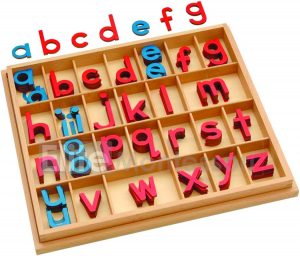Elements of Montessori Education for Young Children
 ABSORBENT MIND
ABSORBENT MIND
Dr. Montessori believed that the brains of young children work in a different way from that of adults. She referred to the time from birth – 6 as the “Absorbent Mind.” During the period of the absorbent mind, young children are capable of absorbing immense amounts of information about the environment through their senses. A child’s mind acts like a sponge, soaking up information.
SENSITIVE PERIOD
During the period of the absorbent mind, the child passes through a succession of well-defined stages or epochs, which are defined as the “Sensitive Periods.” A sensitive period may be compared to a ray of interest – like a searchlight coming from the child’s mind – which lights up certain things in the world around them with a peculiar vividness and fascination. While it is there, it enables them to absorb those things with an astonishing ease and power. But a sensitive period is a transitory phenomenon, lasting just long enough for the child to establish certain acquisitions and skills. Then it passes – never to return – giving place to another, which in its turn is succeeded by the next, and so on.
PREPARED ENVIRONMENT
The important thing is that no matter how absorbent the child’s mind may be, ultimately, it cannot absorb what is not there. Therefore, Montessori education endeavors to develop the “Prepared Environment” that helps make the fullest use of the absorbent mind of the child. In the Prepared Environment, the child is encouraged to explore Montessori Didactic Materials to meet the needs in each sensitive period at each developmental stage of the child. The Montessori environment is prepared in Practical Life, Sensorial, Language, Mathematics, Culture, and Science areas.
CHARACTERISTICS OF MONTESSORI DIDACTIC MATERIALS
Montessori Didactic Materials, which are unlocked by the well trained Montessori teacher’s presentation to the child, have the following characteristics.
- HANDS-ON ACTIVITY
In Montessori education, children have plenty of time for opportunities to learn by exploring Montessori’s Didactic Materials through seeing, hearing, touching, feeling, and manipulating with. In the child’s term, NOTHING IN MY HANDS, NOTHING IN MY BRAIN.
- ISOLATED PROPERTIES
In Montessori education, the property which is intended for the child to learn is isolated so that it helps the child discover it. For example, the Knobbed Cylinders have knobbed cylinder blocks that isolate the concept of diameter. For this, all Knob cylinders have the same shape, height, and texture: only the diameter varies. This principle of property isolation serves to focus the children’s minds on dimensions that vary.
3. CONTROL OF ERROR
Control of error is a method of self-correction that is built into the design of Montessori Didactic materials. Control of error provides children with opportunities to see for themselves when they need to make a correction which allows them to determine independently what the correction should be. Dr. Montessori believed that if the child is given enough time to fix their errors independently, it can help the child build their self-confidence and self-awareness, which allows the work to become an intrinsic reward.
- MATERIALIZED ABSTRACTIONS
Although most adults have an understanding of what color is, the idea of color is actually an abstract concept because it is difficult to explain. What Is red? Or blue? Dr. Montessori recognized the need to make abstract concepts more concrete so children could better understand them.
Therefore, Dr. Montessori designed sensory materials that can provide concrete examples of abstract concepts. Montessori called it “Materialized Abstraction.” By manipulating the materials, what was once known only to the brain is now understood through the kinesthetic movement of the body, which enables the children to clearly recall those abstract impressions (Excerpted from NAMC).
- HIDDEN LOGICS
When children work with Montessori Materials, they have fun playing with them. Although children are not aware of this, there is a cognitively precise step-by-step logic hidden within their materials, and it is designed to scaffold the child’s future learning.
| (a+b)3 = a3+3a2b+3ab2+b3 |
For example, the Binomial Cube is one of children’s favorite puzzles. Although it may seem to them that they are just playing with puzzles, they are actually forming the basic foundations of algebra.
- DISCOVERY LEARNING
In Montessori, phonetic alphabet sounds are used instead of the names of alphabets. The child learns how to sound the letters through games using the Sound Pouches. Before a child can use pencil and paper to write words, they use the “Movable Alphabets” to write words. For example, when the child wants to make the word, “cat,” he sounds out each sound such as /k/, /a/, and then they ask the teacher, “Which letter makes /t/ sound?” This is a great time to introduce the child that the letter ‘t’ makes the /t/ sound. Montessori class is where discovery learning occurs, and it is through this discovery that children experience the joys of learning
